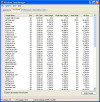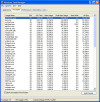Lately my computer has been getting slower by the day. Attached are images of the 'Processes' tab in the task mgr.
Image 1: List of processes sorted by CPU
Image 2: List sorted by Memory Usage
If you look at image 1, the System Idle Process CPU Usage = 92%. However, right at the bottom of the Task Mgr, you see CPU Usage to be 51%. Sometimes it goes up to 75% too. Don't quite understand the discrepancy.
I always thought that 100% - System Idle Process% = CPU Usage%. Is my assumption wrong?
Or is there some kind of unlisted process running in the background - like a virus or so? If yes, how do I detect it/them? Doing a malware/spyware/virus check using Avast, Super-antispyware, Malwarebytes hasn't found anything yet.
The other thing that I can think of is that it could be because my hard drive is running low - have only 1.5GB of 59GB left. which brings me to my next issue. The C:\Windows\Installer folder is taking up 23.2GB. WTH?!!!
Anyone know what's screwing things on my machine?
Sys Details:
Win XP Home - SP3
1.5GB RAM
C Drive: Used: 1.59 of 55.4GB
D Drive: Used: 8.94 of 19.0GB
Thanks!


